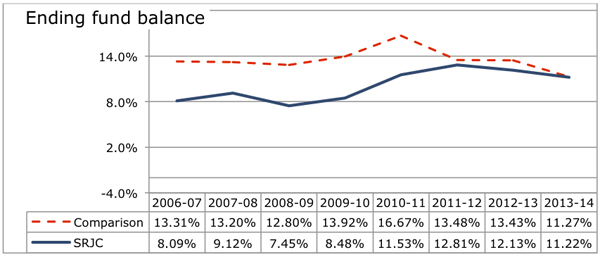
Negotiations Update Spring 2015
Part 1
The 2015-16 Governor's Proposal and SRJC
As last week's District email to faculty and staff stated, "there's a lot to like" for SRJC in the Governor's budget proposal this year. The Governor's proposal allocates $1.1 billion in new revenues for CCC in 2015-16, which is 60% greater than the District's December prediction. Also, the so-called "wall of debt," the deferrals of payments to CCC started in the Schwarzenegger years, is all but gone, so this year's additional funding can be applied to improving SRJC's programs as well as restoring faculty salaries, benefits, and working conditions.
Here are the highlights for community colleges and the resulting revenue adjustments for SRJC:
- An increase in overall base funding of 3.6%, which would bring $3.6 million to SRJC. Typically this new base funding would be labeled as COLA (Cost of Living Adjustment). This year, however, the Governor's proposed budget designates only 1.58% of the base funding increase as COLA, and the remaining 2% as just a "base funding increase."
- An apportionment equalization resulting in another $0.8 million to the College.
- A backfill in 2015-16 for previously unfunded costs for state mandates, which will bring $6.2 million to SRJC.
- A funding augmentation for Student Success Programs and Student Equity Programs, which will bring SRJC an additional $0.5 million of revenue.
- A CCC base enrollment growth allowance of 2.0%, but it's unlikely that SRJC, which has experienced flat enrollments in the past few years, will be able to take advantage of any growth funding in 2015-16.
The bottom line is that the District's revenue will increase by approximately $11 million in 2015-16 under the Governor's budget proposal. The consensus is that budget-wise, the 2015-16 academic year will be the rosiest in a long time. There are some concerns, however.
The District will be faced with increased expenditures in 2015-16 as well. Meeting the Rank Ten contractual obligation will increase the overall faculty payroll by at least $1.6 million. District obligations for CalSTRS and CalPERS will grow by $0.9 million. District employee health benefit premiums may grow by as much as $0.6 million. An oversight in District attendance reporting in 2013-14 may reduce revenues by $1.2 million. And finally, as the District continues its strategy of toggling on and off stability funding, SRJC is exposed to a possible loss of revenue of up to $1.3 million should its enrollment drop in 2015-16.
The District has also expressed some anxiety over SRJC's projected 2014-15 ending reserves. Table 1 shows SRJC's ending unrestricted reserves compared with the median of ending unrestricted reserves for SRJC's comparison districts over the last eight years. Some in the District have projected SRJC's 2014-15 ending reserves will drop dramatically from 2013-14, but some individuals, according to the District, see those reserves remaining well above the 5% minimum required by the state. The lesson learned from the last four years is that predicting SRJC's ending reserves before the close of the fiscal year has proven to be a difficult task.

Table 1: Unrestricted Reserves: SRJC vs. SRJC Comparison Group median1
A lot can happen—both good and bad—between now and June, when the 2015-16 budget is eventually approved by the legislature. Presently, AFA is working with the Faculty Association of California Community College (FACCC) and California Community College Independents (CCCI) in Sacramento on restoring even more much-needed CCC funding, especially in the areas of part-time faculty categorical programs. Visit the advocacy page on the AFA website to see how you can help.
2015-16 Rank Ten SRJC Faculty Salary
The baseline for all SRJC faculty salary negotiations is Rank Ten. This methodology, which maintains competitive faculty salary schedules, is essential for recruiting and keeping high-quality faculty at SRJC. (Be sure to read Will Baty's Dialogue piece, The Rank 10 Covenant—Why It Matters, http://www.santarosa.edu/afa/1314/Publications/Dialog/140505.html.)
The Rank Ten methodology determines all faculty salary schedules based on the annual AFA salary study and the state-determined COLA. Assuming the Governor's 1.58% COLA proposal is enacted by the legislature in June, Rank Ten in 2015-16 will require a 3.08% overall increase in salaries from 2014-15. (The actual increase will vary by salary step.)
The tentative 2015-16 faculty salary schedules are at http://www.santarosa.edu/afa/RankTen.pdf. (Of course, all faculty salaries are subject to negotiation and approval by the District and by AFA membership.)
As negotiations progress this year, you will be receiving more updates. Feel free to contact the AFA office or email me directly (wruud@santarosa.edu) if you have comments or questions on negotiation issues.
1Districts in the SRJC Comparison Group: Cerritos, El Camino, Glendale, Long Beach, Palomar, San Joaquin Delta, Santa Barbara, Santa Monica, Sonoma. The 2013-14 Comparison Group median is from budgeted unrestricted reserves.